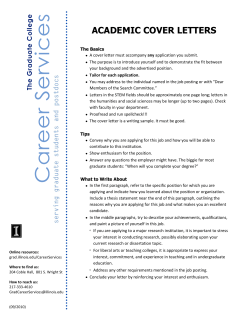
How to run SIESTA Introduction to input & output files
SUMMER SCHOOL ON COMPUTATIONAL MATERIALS SCIENCE University of Illinois at Urbana-Champaign, June 13-23, 2005 How to run SIESTA Introduction to input & output files SUMMER SCHOOL ON COMPUTATIONAL MATERIALS SCIENCE University of Illinois at Urbana-Champaign, June 13-23, 2005 Linear-scaling DFT based on Numerical Atomic Orbitals (NAOs) • Born-Oppenheimer • DFT • Pseudopotentials • Numerical atomic orbitals • • • • relaxations, MD, phonons. LDA, GGA norm conserving, factorised. finite range • Numerical evaluation of matrix elements P. Ordejon, E. Artacho & J. M. Soler , Phys. Rev. B 53, R10441 (1996) J. M.Soler et al, J. Phys.: Condens. Matter 14, 2745 (2002) SUMMER SCHOOL ON COMPUTATIONAL MATERIALS SCIENCE University of Illinois at Urbana-Champaign, June 13-23, 2005 What do we need? • Access to the executable file: siesta • An input file • Flexible Data Format (fdf) (A. García & J.M. Soler). • A psedopotential file for each kind of element in the input file. • Unformatted binary (vps) • Formatted ASCII (.psf): more transportable and readable SUMMER SCHOOL ON COMPUTATIONAL MATERIALS SCIENCE University of Illinois at Urbana-Champaign, June 13-23, 2005 Siesta package: (under license) • Src: Sources of the Siesta code • Docs: Documentation and user conditions • User’s Guide (siesta.tex) • Pseudo: ATOM program to generate and test • • pseudopotentials Examples: fdf and pseudopotentials input files for simple systems Utils: Programs or scripts to analyze the results SUMMER SCHOOL ON COMPUTATIONAL MATERIALS SCIENCE University of Illinois at Urbana-Champaign, June 13-23, 2005 The input file • Main input file: • • • Flexible Data Format (FDF) Physical data of the system Variables to control the approximations SUMMER SCHOOL ON COMPUTATIONAL MATERIALS SCIENCE University of Illinois at Urbana-Champaign, June 13-23, 2005 FDF characteristics (II) • • • Data can be given in any order Data can be omitted in favour of default values. Labels are case insensitive and characters `-´ , `_´, `.´ are ignored: LatticeConstant is equivalent to lattice_constant • • Text following # are comments You may ‘include’ other FDF files or redirect the search to another file SUMMER SCHOOL ON COMPUTATIONAL MATERIALS SCIENCE University of Illinois at Urbana-Champaign, June 13-23, 2005 FDF characteristics (II) •Syntax: ‘data label’ followed by its value Character string: Integer: Real: Logical: Physical magnitudes •Physical magnitudes: SystemLabel NumberOfAtoms PAO.SplitNorm SpinPolarized LatticeConstant h2o 3 0.15 .false. 5.43 Ang followed by their units. Many units are valid for the same magnitude (m, cm, nm, Ang, Bohr). There is an automatic conversion to the units required internally. • Character strings, NOT in apostrophes SUMMER SCHOOL ON COMPUTATIONAL MATERIALS SCIENCE University of Illinois at Urbana-Champaign, June 13-23, 2005 FDF characteristics (III) • Logical values: T / .true. / true / yes F / .false. / false / no • Complex data structures: blocks %block label … %endblock label SUMMER SCHOOL ON COMPUTATIONAL MATERIALS SCIENCE University of Illinois at Urbana-Champaign, June 13-23, 2005 Basic input variables a) b) c) d) e) f) General system descriptors Structural and geometrical variables Functional and solution mehod Convergence of the results Self-consistency Basis set generation related variables. SUMMER SCHOOL ON COMPUTATIONAL MATERIALS SCIENCE University of Illinois at Urbana-Champaign, June 13-23, 2005 General System description SystemName: descriptive name of the system SystemName Si bulk, diamond structure SystemLabel: nickname to label output files SystemLabel silicon After a succesful run, you should have files like silicon.DM : Density matrix silicon.XV : Final positions and velocities silicon.EIG : Eigen-energies ... SUMMER SCHOOL ON COMPUTATIONAL MATERIALS SCIENCE University of Illinois at Urbana-Champaign, June 13-23, 2005 Geometrical and structural variables NumberOfAtoms: number of atoms in the simulation NumberOfAtoms 2 NumberOfSpecies: number of different atomic species NumberOfSpecies 1 ChemicalSpeciesLabel: specify the different chemical species. %block ChemicalSpeciesLabel 1 14 Si %endblock ChemicalSpeciesLabel ALL THESE VARIABLES ARE MANDATORY!! SUMMER SCHOOL ON COMPUTATIONAL MATERIALS SCIENCE University of Illinois at Urbana-Champaign, June 13-23, 2005 Lattice Vectors LatticeConstant: length to define the scale of the lattice vectors LatticeConstant 5.43 Ang LatticeParameters: Crystallograhic way %block LatticeParameters 1.0 1.0 1.0 60.0 60.0 60.0 %endblock LatticeParameters LatticeVectors: read as a matrix, each vector being a line %block LatticeVectors 0.0 0.5 0.5 0.5 0.0 0.5 0.5 0.5 0.0 %endblock LatticeVectors SUMMER SCHOOL ON COMPUTATIONAL MATERIALS SCIENCE University of Illinois at Urbana-Champaign, June 13-23, 2005 Periodic Boundary Conditions (PBC) Atoms in the unit cell are periodically repeated throughout space along the lattice vectors • Periodic systems and crystalline solids: • Aperiodic systems: Supercell approximation Defects Molecules Surfaces SUMMER SCHOOL ON COMPUTATIONAL MATERIALS SCIENCE University of Illinois at Urbana-Champaign, June 13-23, 2005 Atomic Coordinates AtomicCoordinatesFormat: format of the atomic positions in input: Bohr: cartesian coordinates, in bohrs Ang: cartesian coordinates, in Angstroms ScaledCartesian: cartesian coordinates, units of the lattice constant Fractional: referred to the lattice vectors AtomicCoordinatesFormat AtomicCoordinatesAndAtomicSpecies: Fractional %block AtomicCoordinatesAndAtomicSpecies 0.00 0.00 0.00 1 Si 0.25 0.25 0.25 1 Si %endblock AtomicCoordinatesAndAtomicSpecies SUMMER SCHOOL ON COMPUTATIONAL MATERIALS SCIENCE University of Illinois at Urbana-Champaign, June 13-23, 2005 XC-functional DFT XC.Functional XC.authors LDA CA PZ SpinPolarized GGA PW92 PBE CA Ceperley-Alder PZ Perdew-Zunger PW92 Perdew-Wang-92 PBE Perdew-Burke-Ernzerhof SUMMER SCHOOL ON COMPUTATIONAL MATERIALS SCIENCE University of Illinois at Urbana-Champaign, June 13-23, 2005 Solution method Two options to solve the electronic problem (Kohn-Sham equations) From the atomic coordinates and the unit cell R, a Order N operations H S C 0 Hamiltonian, H, and Overlap, S, matrices SolutionMethod diagon ordern SUMMER SCHOOL ON COMPUTATIONAL MATERIALS SCIENCE University of Illinois at Urbana-Champaign, June 13-23, 2005 K-point sampling Spetial set of k-points: Accurate results for a small # k-points: Baldereschi, Chadi-Cohen, Monkhorst-Pack kgrid_cutoff: Kgrid_cutoff 10.0 Ang kgrid_Monkhorst_Pack: %block kgrid_Monkhorst_Pack 4 0 0 0.5 0 4 0 0.5 0 0 4 0.5 %endblock kgrid_Monkhorst_Pack r atom r Initial guess r , , out in , Mixing , , VH r ,Vxc r Self-consistent Linear: DM.MixingWeigth NonLinear (Pulay): DM.NumberPulay out , MaxSCFIterations out , in , DM.Tolerance iterations Ĥ Total energy Charge density Forces SUMMER SCHOOL ON COMPUTATIONAL MATERIALS SCIENCE University of Illinois at Urbana-Champaign, June 13-23, 2005 How to run siesta • To run the serial version: [path]/siesta < input.fdf > output & • To see the information dumbed in the output file while it runs tail –f output • Alternatively: [path]/siesta < input.fdf | tee ouput SUMMER SCHOOL ON COMPUTATIONAL MATERIALS SCIENCE University of Illinois at Urbana-Champaign, June 13-23, 2005 Analysing the output (I) The output header Siesta version Fortran compiler SUMMER SCHOOL ON COMPUTATIONAL MATERIALS SCIENCE University of Illinois at Urbana-Champaign, June 13-23, 2005 Analysing the output (II) dumping the input file SUMMER SCHOOL ON COMPUTATIONAL MATERIALS SCIENCE University of Illinois at Urbana-Champaign, June 13-23, 2005 processing the input SUMMER SCHOOL ON COMPUTATIONAL MATERIALS SCIENCE University of Illinois at Urbana-Champaign, June 13-23, 2005 coordinates and k-sampling SUMMER SCHOOL ON COMPUTATIONAL MATERIALS SCIENCE Output: First MD step SUMMER SCHOOL ON COMPUTATIONAL MATERIALS SCIENCE Output: Self-consistency SUMMER SCHOOL ON COMPUTATIONAL MATERIALS SCIENCE University of Illinois at Urbana-Champaign, June 13-23, 2005 Output: Eigenvalues, forces, stress SUMMER SCHOOL ON COMPUTATIONAL MATERIALS SCIENCE University of Illinois at Urbana-Champaign, June 13-23, 2005 Output: Total energy SUMMER SCHOOL ON COMPUTATIONAL MATERIALS SCIENCE University of Illinois at Urbana-Champaign, June 13-23, 2005 Output: timer SUMMER SCHOOL ON COMPUTATIONAL MATERIALS SCIENCE University of Illinois at Urbana-Champaign, June 13-23, 2005 Saving & reading information (I) Some information is stored by Siesta and can be used to restart the simulations from previous a run: • Density matrix: DM.UseSaveDM • Localized wave functions (Order-N): ON.UseSaveLWF • Atomic positions and velocities: MD.UseSaveXV • CG history (minimizations): MD.UseSaveCG All of them are logical variables (and save lots of time!!) SUMMER SCHOOL ON COMPUTATIONAL MATERIALS SCIENCE University of Illinois at Urbana-Champaign, June 13-23, 2005 Saving & reading information (II) Information needed as input for various post-processing programs, for example, to visualize: •Total charge density: SaveRho •Deformation charge density: SaveDeltaRho •Electrostatic potential: SaveElectrostaticPotential •Total potential: SaveTotalPotential •Local density of states: LocalDensityOfStates •Charge density contours: WriteDenchar •Atomic coordinates: WriteCoorXmol and WriteCoorCerius All of them are logical variables SUMMER SCHOOL ON COMPUTATIONAL MATERIALS SCIENCE University of Illinois at Urbana-Champaign, June 13-23, 2005 Analyzing the electronic structure (I) • Band structure along the high symetry lines of the BZ • BandLineScale: scale of the k vectors in BandLines BandLinesScale • pi/a BandLines: lines along with band energies are calculated. %block BandLines 1 1.000 1.000 20 0.000 0.000 25 2.000 0.000 30 2.000 2.000 %endblock BandLines 1.000 0.000 0.000 2.000 L \Gamma X \Gamma SUMMER SCHOOL ON COMPUTATIONAL MATERIALS SCIENCE University of Illinois at Urbana-Champaign, June 13-23, 2005 Analyzing the electronic structure (II) Density Of States: total and projected on the atomic orbitals • Compare with experimental spectroscopy • Bond formation • ProjectedDensityOfStates: %block ProjectedDensityOfStates -20.00 10.00 0.200 500 eV %endblock ProjectedDensityOfStates Lower energy Higher energy width # points SUMMER SCHOOL ON COMPUTATIONAL MATERIALS SCIENCE University of Illinois at Urbana-Champaign, June 13-23, 2005 Analyzing the electronic structure (III) Population analysis: Mulliken prescription • • • Amounts of charge on an atom or in an orbital inside the atom Bond formation Be careful, very dependent on the basis functions WriteMullikenPop 0 1 2 3 = None = Atomic and orbitals charges = 1 + atomic overlap pop. = 2 + orbital overlap pop. SUMMER SCHOOL ON COMPUTATIONAL MATERIALS SCIENCE University of Illinois at Urbana-Champaign, June 13-23, 2005 Utilities (I) Various post-processing tools: • PHONONS: Finite differences: VIBRA (P. Ordejón) • Linear response: LINRES ( M. Pruneda et al.) • Interphase with Phonon program (Parlinsky) • • Visualization of the CHARGE DENSITY and POTENTIALS • • • -3D: PLRHO (J. M. Soler), grid2cube, grid2xfs, … -2D: CONTOUR (E. Artacho) -2D: DENCHAR (J. Junquera) SUMMER SCHOOL ON COMPUTATIONAL MATERIALS SCIENCE University of Illinois at Urbana-Champaign, June 13-23, 2005 Utilities (II) • TRANSPORT PROPERTIES: • • • • PSEUDOPOTENTIAL and BASIS information: • PyAtom (A. García). XML output: • • TRANSIESTA (M. Brandbydge et al.), SMEAGOL (S. Sanvito et. al.) • Visualization of the ouput (J. Wakelin & A. García). PDOS-xml tool (A. García) ATOMIC COORDINATES: • Sies2arc (J. Gale)
© Copyright 2025











